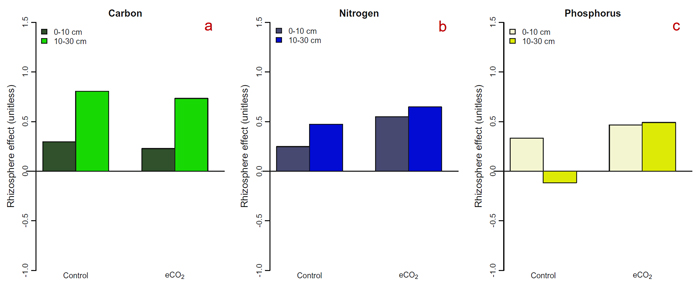| Tweet | Follow @co2science |
Paper Reviewed
Ochoa-Hueso, R., Hughes, J., Delgado-Baquerizo, M., Drake, J.E., Tjoelker, M.G., Piñeiro, J. and Power, S.A. 2017. Rhizosphere-driven increase in nitrogen and phosphorus availability under elevated atmospheric CO2 in a mature Eucalyptus woodland. Plant and Soil 416: 283-295.
In providing the rationale for their work, Ochoa-Hueso et al. (2017) write that "in the absence of external nutrient inputs (e.g., via fertilization or high levels of atmospheric nitrogen (N) deposition), plant growth enhancement under elevated CO2 may not be maintained in the long-term due to progressive nutrient limitation." However, they note that higher rates of plant growth in response to elevated CO2 may be sustained via enhanced rhizosphere activity, whereby elevated CO2 stimulates a "rhizosphere-induced increase in soil nutrient availability." Thus, they set out to conduct an experiment to see if this latter hypothesis is correct.
Their work was conducted using Free-Air CO2 Enrichment (FACE) technology at a phosphorus (P)-limited mature eucalypt (Eucalyptus tereticornis) woodland in southeastern Australia. CO2 enrichment (eCO2) was provided during the daylight hours only and was maintained at a concentration of 150 ppm above ambient levels. After 17 months of CO2 enrichment the scientists conducted a number of measurements on the bulk (10-30 cm) and rhizosphere (0 to 10 cm) soil, including the activity of seven enzymes related to the carbon (C), nitrogen (N) and phosphorus (P) cycles. And what did those measurements reveal?
In the words of Ochoa-Hueso et al., they say that their study provided "novel evidence suggesting that rhizosphere processes in a mature eucalypt forest ecosystem can respond rapidly (<2 years) to atmospheric CO2 enrichment." More specifically, they demonstrated that "several early belowground responses of a P-limited forested ecosystem to eCO2 are associated with an alteration in the allocation of resources to strategies that enhance the ability of plants to acquire resources (particularly inorganic P and N) necessary to maintain increased plant metabolism and potentially, therefore, growth under eCO2." And in this regard they describe "a synchronized down- (0-10 cm) and up-regulation (10-30 cm) of rhizosphere activity that was associated with an overall increase in inorganic P and N availability in the rhizosphere across the entire soil profile studied" (see figure below). Consequently, Ochoa-Hueso et al. conclude that their findings suggest that "rhizosphere-mediated increases in soil organic matter decomposition and enhanced nutrient availability may thus be an important mechanism in promoting plant growth in response to elevated CO2 in this and perhaps other nutrient-poor ecosystems."
The above findings are tremendously good news, as they confirm that "plants can shape the composition of their rhizosphere microbiome, which is crucial for plant health and the tolerance of biotic and abiotic stresses." Thus, plants will likely not experience nutrient limitation under elevated CO2 as some have feared.

Figure 1. Effects of elevated CO2 on (a) hydrolysable carbon, (b) nitrogen (DIN), and (c) phosphorus (PO4) availability in bulk (10 to 30 cm depth) and rhizosphere (0 to 10 cm depth) soil. Source: Ochoa-Hueso et al. (2017).




